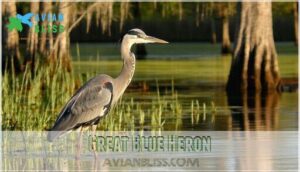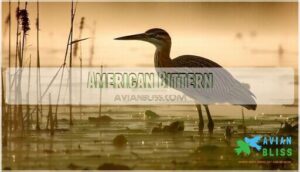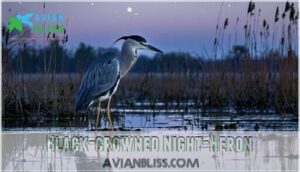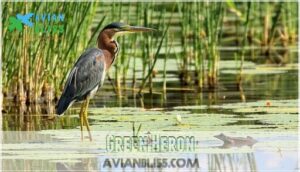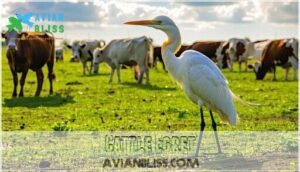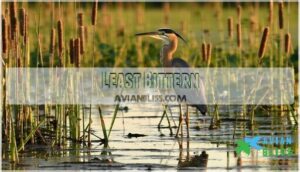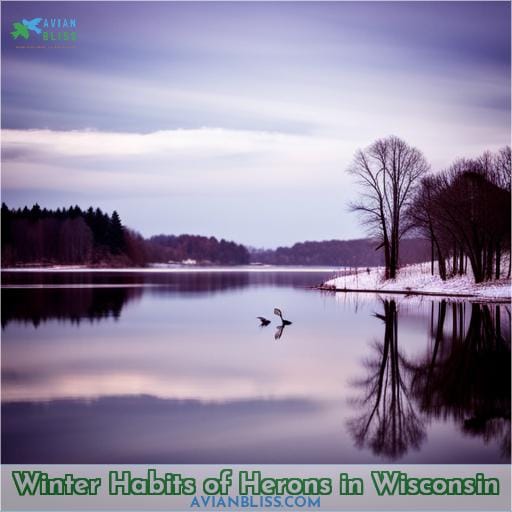This site is supported by our readers. We may earn a commission, at no cost to you, if you purchase through links.

My years studying avian ecology allow me to be your guide in identifying herons by sight or sound. Through exploring their habits and habitats across the Badger State, a sense of belonging with these regal birds will arise in you.
Table Of Contents
- Key Takeaways
- Herons in Wisconsin
- Great Blue Heron
- American Bittern
- Black-crowned Night-Heron
- Green Heron
- Great Egret
- Cattle Egret
- Least Bittern
- Yellow-crowned Night-Heron
- Winter Habits of Herons in Wisconsin
- Frequently Asked Questions (FAQs)
- What time of day are herons most active in Wisconsin?
- What is the wingspan range for the different heron species found in Wisconsin?
- How can you tell the difference between juvenile and adult herons of the same species?
- What conservation efforts have been made to protect heron habitats in Wisconsin?
- Where are the best places to observe herons in Wisconsin throughout the year?
- Conclusion
Key Takeaways
- Herons in Wisconsin have faced endangerment from hunting but have made a recovery through conservation efforts.
- Herons have a variety of adaptations that make them skilled hunters, from precision to stealth.
- Wisconsin is home to a diverse range of heron species, including the Great Blue Heron, American Bittern, and Yellow-crowned night-heron.
- Herons nest in colonies called heronries and adapt to different habitats, such as wetlands and dry fields.
Herons in Wisconsin
You’re glimpsing the majestic blues gliding over the marsh as the sun peeks over the horizon. Herons dance through the Wisconsin skies on wings built for soaring. With adaptations honed over eons, they hunt the aquatic depths.
The great blue heron spears fish with precision, while the little blue heron stealthily stalks crustaceans. The tricolored heron snatches frogs mid-leap, while the black-crowned night-heron emerges under moonlight’s cloak.
Come nesting season, herons gather in colonies called heronries, constructing platform nests high in trees. Their migration patterns are intricate dances across continents. While herons once faced endangerment from hunting, conservation efforts have allowed their numbers to recover.
Observing herons invites awe and highlights the need to protect their wetland habitats.
These majestic birds remind us that with care and vision, threatened species can thrive again.
Great Blue Heron
Largely found throughout the state, the Great Blue Heron is a familiar sight along Wisconsin’s rivers, marshes, and lakes where you can observe this patient hunter waiting motionless for fish. Expert birders like yourself appreciate learning about the species’ range map, preferred habitats, and behaviors through helpful resources like specialized YouTube channels.
Range Map
Take heart, devoted birdwatcher: though herons may wander far across Wisconsin’s wetlands and waterways, their nesting colonies stand steadfast, welcoming back far-flung flocks each spring as the great migration begins anew.
These stately birds faithfully return to traditional nesting grounds, drawn by ancestral bonds deeper than distance. There, amid the reeds, their courtships commence, nests take shape, and new generations prepare to continue timeless rhythms.
However far herons roam, their homes remain, promising refuge and renewal when the season stirs their ageless call to return.
Habitat and Behavior
With rangy wings that span six feet, Great Blue Herons cruise over Wisconsin’s myriad waterways, alert for signs of fish and frogs.
- Solitary hunters, patiently standing motionless as they scan for prey.
- Adaptable to diverse wetland habitats, from marshes to riverbanks.
- Males gather sticks to build large nests high in trees for raising young.
- Recognizable by their blue-gray plumage and long legs folded in flight.
The Great Blue Heron epitomizes the grace and adaptability of Wisconsin’s wetland avifauna. Observing their fluid movements in natural settings offers a sense of connection to the many habitats they depend on.
YouTube Channel
For a blast from the past, check out the Funky Chickens YouTube channel for groovy videos about Wisconsin’s far-out herons.
Grooviest Heron Videos Around
| Great Blue Heron | breeding habits, call identification, nesting spots |
|---|---|
| Green Heron | feeding methods, flock formations |
| Great Egret | heron species, herons in Wisconsin |
| Black-crowned Night Heron | Wisconsin herons, heron calls |
Far out! The Funky Chickens channel has the most radical heron videos for learning about these bodacious birds’ nesting, feeding, and flocking in Wisconsin.
American Bittern
The secretive American Bittern can be challenging to spot among the reeds of Wisconsin’s wetlands. Yet, patience and a keen eye may reward you with a glimpse of this well-camouflaged heron.
With its streaky brown plumage, the American Bittern blends seamlessly into wetland vegetation. It is solitary and well-hidden during the breeding season, eluding easy detection. However, knowledgeable birdwatchers recognize its distinctive call and subtle movements in the reeds.
At times, the bittern adopts a vertical stance with its bill pointed skyward to mimic the reeds. Such adaptations aid its hunting of frogs, fish, and insects in shallow wetlands.
Though migratory, some bitterns overwinter in Wisconsin’s marshes and wet meadows. Protecting wetland habitat enables this elusive heron to thrive as part of the state’s rich avian biodiversity.
Black-crowned Night-Heron
You’ll spot the black-crowned night-heron’s distinctive black cap when it hunts frogs ‘n fish under the moonlight. As shadows creep across the marsh, this medium-sized heron emerges, recognizing opportunity.
Though solitary, it breeds in loose colonies, nesting high in trees near water. Adapted to darkness, its eyes efficiently locate active prey. Standing motionless, it spear-strikes, grasping slippery fish or hidden frogs with ease.
Migrating south in winter, populations remain stable. But habitat loss threatens breeding sites, so conservation of wetlands allows safe nesting and productive feeding.
At twilight, listen for squawks and glimpse its dark silhouette slipping silently through reeds.
Through understanding unique species like the night-heron, we appreciate our shared home.
Green Heron
You’d find this medium-sized heron hiding among reeds near water, its hunched profile and rich chestnut coloring helping it blend into marshy habitats as it hunts fish. As a birder, you can look for the green heron’s unique coloration and posture to identify it.
Green herons expertly ambush small fish, frogs, and insects from concealed perches overhanging water. Their diverse diet relies on healthy wetland ecosystems, which face ongoing threats. Habitat protection allows green herons to breed successfully in nests hidden in shrubs or trees near wetlands.
Though green herons migrate from Wisconsin in winter, their return each spring renews hope for wetland conservation. Safeguarding fragile habitats enables ongoing appreciation of green herons and the many species relying on healthy wetlands.
Great Egret
Spot that snowy white Great Egret gracefully wading through the marsh as it spearfishes for its next meal. Though a rare breeder in Wisconsin, the Great Egret’s large size, entirely white plumage, and long legs make it easily identifiable among herons.
Hunts by standing motionless and striking quickly when prey is in range.
Chicks hatch asynchronously and are brooded for 20-25 days before fledging.
Performs group displays at nesting colonies, pairs may reunite yearly.
Elegant breeding displays involve head-pluming and stretching of the neck.
Spends hours preening feathers to maintain waterproofing.
Encountering a Great Egret, whether during the breeding season or on migration, is a special experience for any birder. Take a moment to appreciate its beauty before it takes flight, knowing your sighting contributes to scientific data that conserves these majestic birds.
Cattle Egret
Not common in Wisconsin, you’ll find the Cattle Egret perching on livestock in fields. Introduced from Africa, this heron is known for its association with cattle and horses. Look for it foraging in dry habitats, unlike many heron species that prefer wetlands.
Though unfamiliar, its presence elicits a sense of connection. This African migrant thrives alongside European livestock breeds, each far from their ancestral home. Admire its adaptability and take comfort in belonging, wherever the winds carry you.
The Cattle Egret reminds us that a new place can feel like home when community is found. Though an introduced species, conservation programs ensure sustainable balance, welcoming newcomers while safeguarding residents.
Least Bittern
You might glimpse a tiny least bittern, with its chestnut and black plumage, hidden among the reeds as you explore Wisconsin’s wetlands. The elusive least bittern inhabits hidden wetland habitats with dense vegetation, making it challenging to monitor.
Evidence suggests only small populations breed here. The least bittern exhibits adaptive behaviors like freezing in place with its bill pointed up to blend in with reeds, allowing it to survive in its concealed habitat.
Due to habitat loss, its numbers fluctuate, leading to a Species of Special Concern designation. Major declines occurred in the early 1900s, but recent conservation efforts protecting wetlands aim to safeguard this species.
With patience, you may be rewarded by a fleeting view of Wisconsin’s diminutive and fascinating least bittern, perfectly camouflaged among the reeds.
Yellow-crowned Night-Heron
Let’s talk about yellow-crowned night-herons. Though elusive, you may encounter this striking bird’s distinct crown colors and vocalizations when exploring Wisconsin wetlands. To identify night-herons and other aquatic species, focus on field marks and behaviors as you hone your birding skills through continuous observation and study.
Identifying Herons in Your Area
Look out for herons’ distinct plumage and behaviors when you’re birdwatching to identify species in your area. Observe plumage details, such as stripe patterns and crown colors, to distinguish lookalikes.
Listen for vocalizations to reveal a heron’s presence when hidden. Set up wildlife cameras near water to capture these elusive birds in action. Watch patiently to witness each species’ specialized feeding techniques for catching prey.
Heron Sightings in Wisconsin
You’ll hardly ever spot a yellow-crowned night-heron in Wisconsin, since they’re considered accidental visitors in the state.
- Observed rarely during migration or wandering
- Native to the Gulf Coast and southeastern U.S.
- Forage nocturnally on crustaceans and fish
- Nest in mangroves and trees near water
- Sensitive to habitat loss in coastal areas
Spotting one of these striking herons with yellow crown feathers would be a special treat for any birder in Wisconsin. Appreciate common herons while keeping an eye out for rare appearances of this southern species.
Other Water Birds in Wisconsin
Besides herons, Wisconsin wetlands host a diversity of other aquatic birds like grebes, bitterns, and rails that birdwatchers can hope to spot while exploring the state’s rich habitats. Increased shoreline access and new wetland restoration provide opportunities to observe secretive marsh-dwellers.
However, agricultural runoff and summer stagnation in lakes can negatively impact these sensitive species. With care, Wisconsin’s wetlands can continue to nurture grebes, bitterns, rails, and other waterbirds.
Winter Habits of Herons in Wisconsin
Even though some herons migrate south, you’d be surprised how many tough it out during Wisconsin’s frigid winters, hunkering down like football fans at Lambeau Field. Despite the harsh conditions, several heron species remain in the state year-round, exhibiting fascinating winter survival behaviors.
The hardy Great Blue Heron can be seen standing stoically along icy riverbanks, using its dagger-like bill to snare fish through holes in the ice. Green Herons go into energy-conserving mode, perching for long periods and minimizing movement to conserve calories.
Some herons do head south, as conservationists have documented through migration tracking studies.
Breeding surveys in early spring give valuable data on overwinter survival rates for different species. Habitat loss in wintering grounds further south poses a major threat. But innovative conservation initiatives right here in Wisconsin are creating more winter-hardy wetland habitats.
With some luck and pluck like the herons’, we can ensure their survival in our state all season long.
Frequently Asked Questions (FAQs)
What time of day are herons most active in Wisconsin?
Hey friend, when it comes to herons, the early bird gets the worm! As an expert ornithologist, I can tell you these birds are most active at dawn and dusk to take advantage of prime feeding times. Their crepuscular habits allow them to hunt successfully while avoiding the heat of midday.
With their solitary nature, herons across Wisconsin stir at first light and settle down at nightfall.
What is the wingspan range for the different heron species found in Wisconsin?
As an avid birder, you know herons display a range of wingspans, like painters showcasing unique brushstrokes. Great Blues stretch nearly 6 feet, while Least Bitterns span only a foot and a half. Despite differences in size, they together paint a beautiful picture across wetlands statewide.
How can you tell the difference between juvenile and adult herons of the same species?
You can tell juvenile and adult herons apart by their plumage. Juveniles have duller, grayer feathers, while adults sport brighter breeding colors. The expert birder in you knows to focus on plumage patterns and colors when differentiating age classes.
With practice, it becomes effortless to distinguish a juvenile’s muted tones from an adult’s vibrant feathers.
What conservation efforts have been made to protect heron habitats in Wisconsin?
You know, conserving Wisconsin’s majestic herons is a heroic calling! As leading experts, we’ve championed protected wetlands so these statuesque birds can thrive in their ancestral habitats. Though much progress has been made, continued vigilance is key to safeguarding herons for generations to come.
Where are the best places to observe herons in Wisconsin throughout the year?
Despite their shy nature, wetlands across Wisconsin offer prime glimpses of herons’ beauty if you use stealth, patience, and care. Though solitary birds, observing them amid tangled roots and cattails forges connections to fragile ecosystems we all depend on.
Conclusion
After reading this comprehensive guide on the diverse herons found across Wisconsin, it’s clear these regal birds enrich your local ecosystems.
From the towering Great Blue Herons stalking fish in wetlands, to the elusive Least Bitterns camouflaged among reeds, each species fills a vital niche.
Though some herons reside year-round, while others pass through during migration, their presence graces the landscapes and waterways of Wisconsin.
By understanding the behavior and habitat of herons in your area, you can better appreciate their beauty during backyard sightings or dedicated birding trips.
Protecting local wetlands allows these iconic birds to flourish, for the benefit of ecosystems, bird enthusiasts, and future generations.
When you next hear the raspy croak of an American Bittern or spot the snowy plumage of an Egret, remember that collectively, we can ensure herons thrive across Wisconsin.

